Environmental Experiences in Lowell: My LP&CT Internship
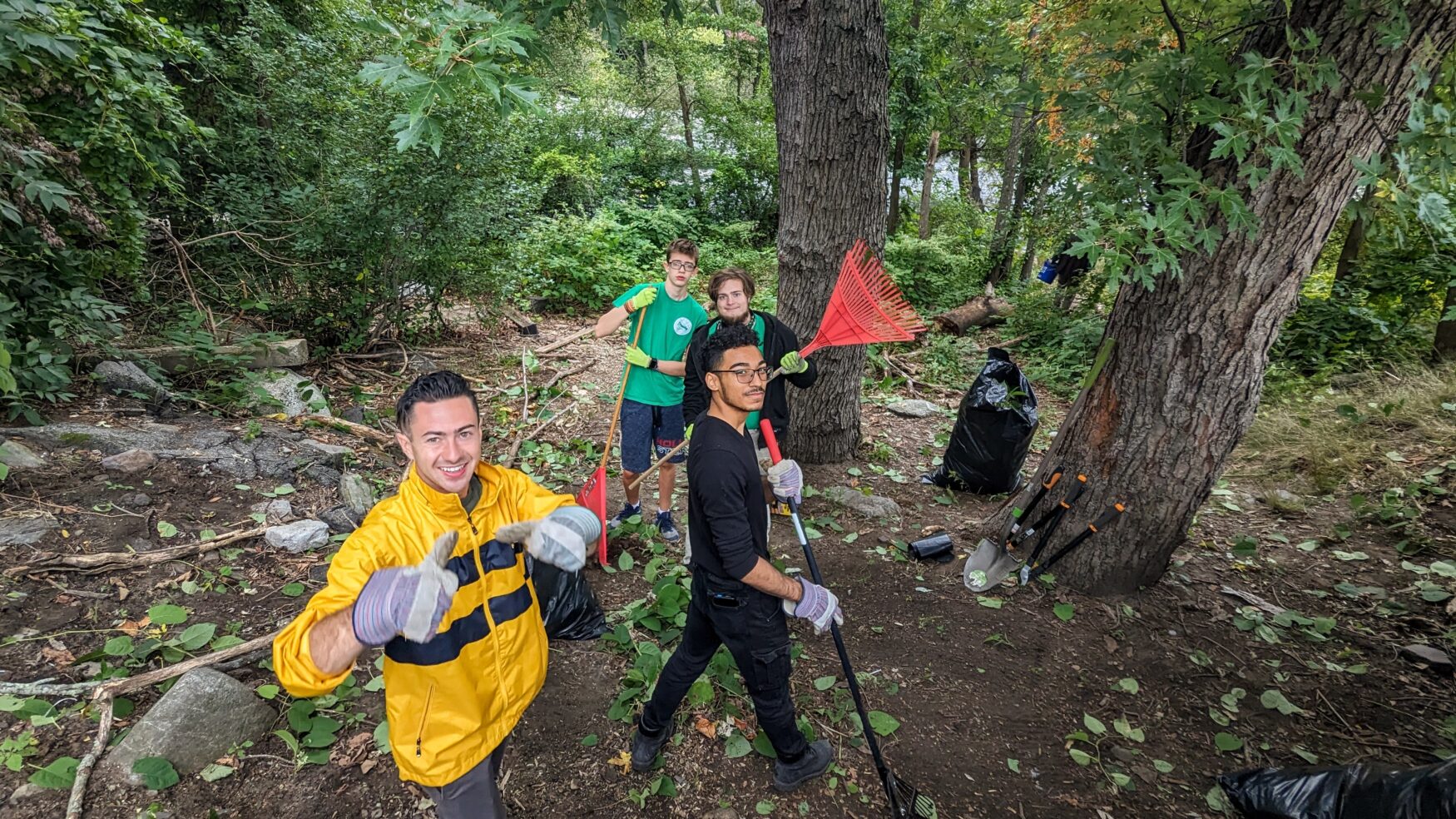
Enthusiastic Walkers Enjoy the Greenway for Annual Meeting (11/18/23)
The rain clouds passed just in time for our Annual Meeting and public walk along the Concord River Greenway on Saturday. For the Annual Meeting, we enjoyed breakfast treats while we got introduced to the Lowell Parks & Conservation Trust board members by the president of the board, Sheila Kirschbaum. In her speech, she said, “When you think about what the Trust does, it comes down to the work of a few members of staff and volunteers, so thank you.” We also got to learn about some other things that the Trust is involved with during the Annual Meeting such as LP&CT’s development on Rollie’s Farm and acceptance into the Nature Everywhere program which encourages children to connect with nature.
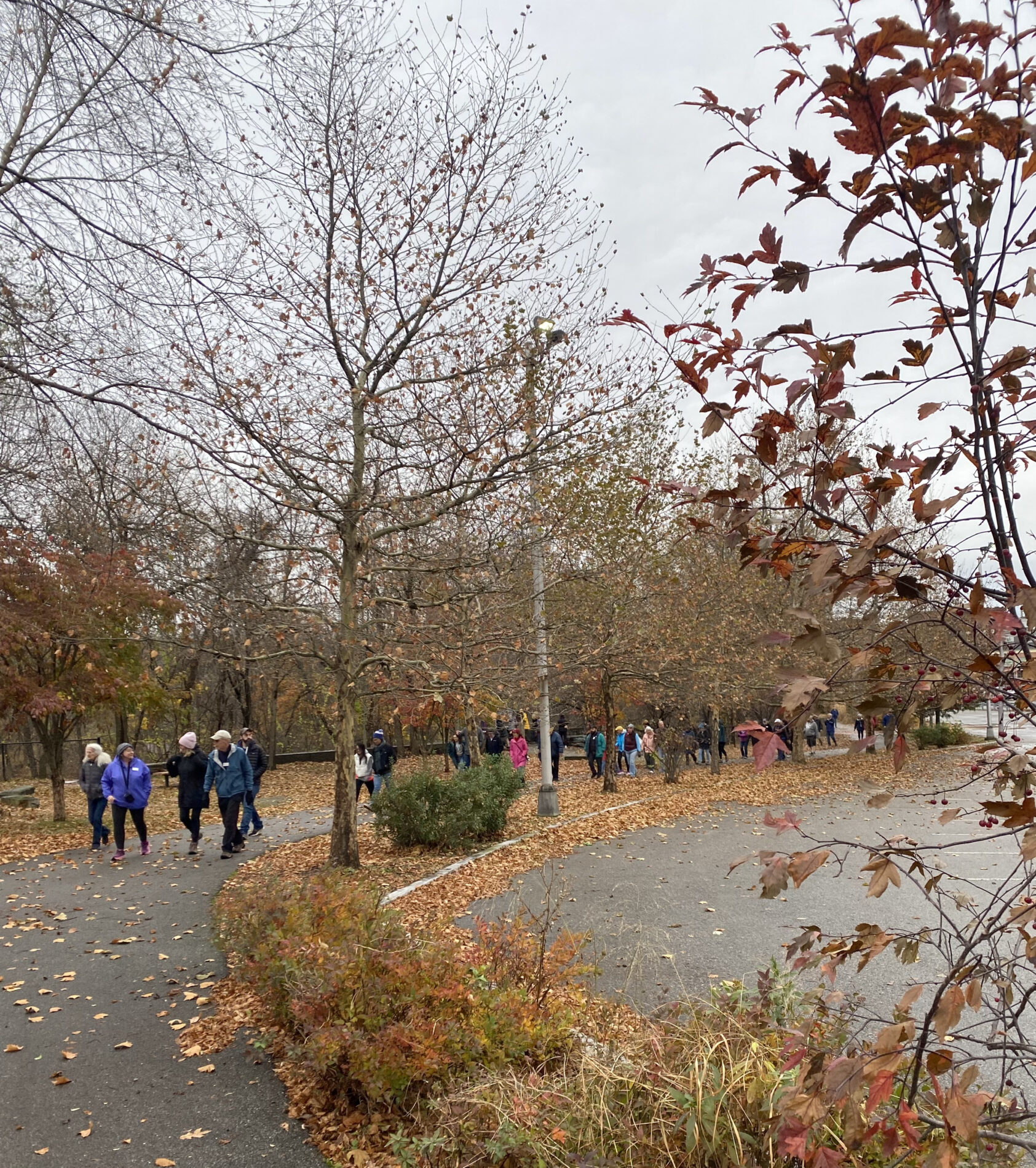
Jane Calvin, LP&CT Executive Director, Leading Walkers on the Greenway.
Then it was time for the walk where we made our way from Davidson Street to Lawrence Street and back, allowing the participants to see both trailhead entrances. Jane Calvin, the Executive Director at the Trust, served as the tour guide during the walk. With close to seventy participants, we had quite a parade of people walking through Lowell. As we walked, we passed some Lowell residents who decided to join us for the event to learn more about the Greenway. We got to take in the beauty of Lowell as we walked, seeing sights such as the Lowell Centennial Island Bridge and the Trust’s fish ladder which helps local species of fish travel upstream.
The walk was reminiscent for me as an intern at the Trust. My first day at the Trust involved helping a volunteering corporate group, HNTB, tidy up the Lawrence Street section of the Greenway. I was so glad that the walkers got to see the work that the HNTB volunteers and I did at the entrance and enjoyed the scenery.
The walk was significant to the Trust because it allowed those who walked to see the vision for what the completed Greenway would eventually look like. The walk between the trailhead entrances helped everyone see how the walkway will actually fit into the city. Mark Romanowsky, a board member for LP&CT, said, “I saw lots of enthusiasm today, and despite the weather conditions we had a great turnout, and great planning context.” Bringing a clearer vision of the Concord River Greenway to the people of Lowell helps bring in support for the project.
A complete Concord River Greenway will help preserve Lowell’s natural and historical beauty, provide a safe way to walk between downtown Lowell and other neighborhoods for residents, and connect the Bay Circuit Trail, a 200-mile trail from Plum Island to Kingston.
If you missed out on the walk, but are interested in other events, we are hosting a Winter Solstice Walk at Hawk Valley Farm on December 21st, and we would love to see you there!
Rocket the Snake Meets Students (12/07/23)
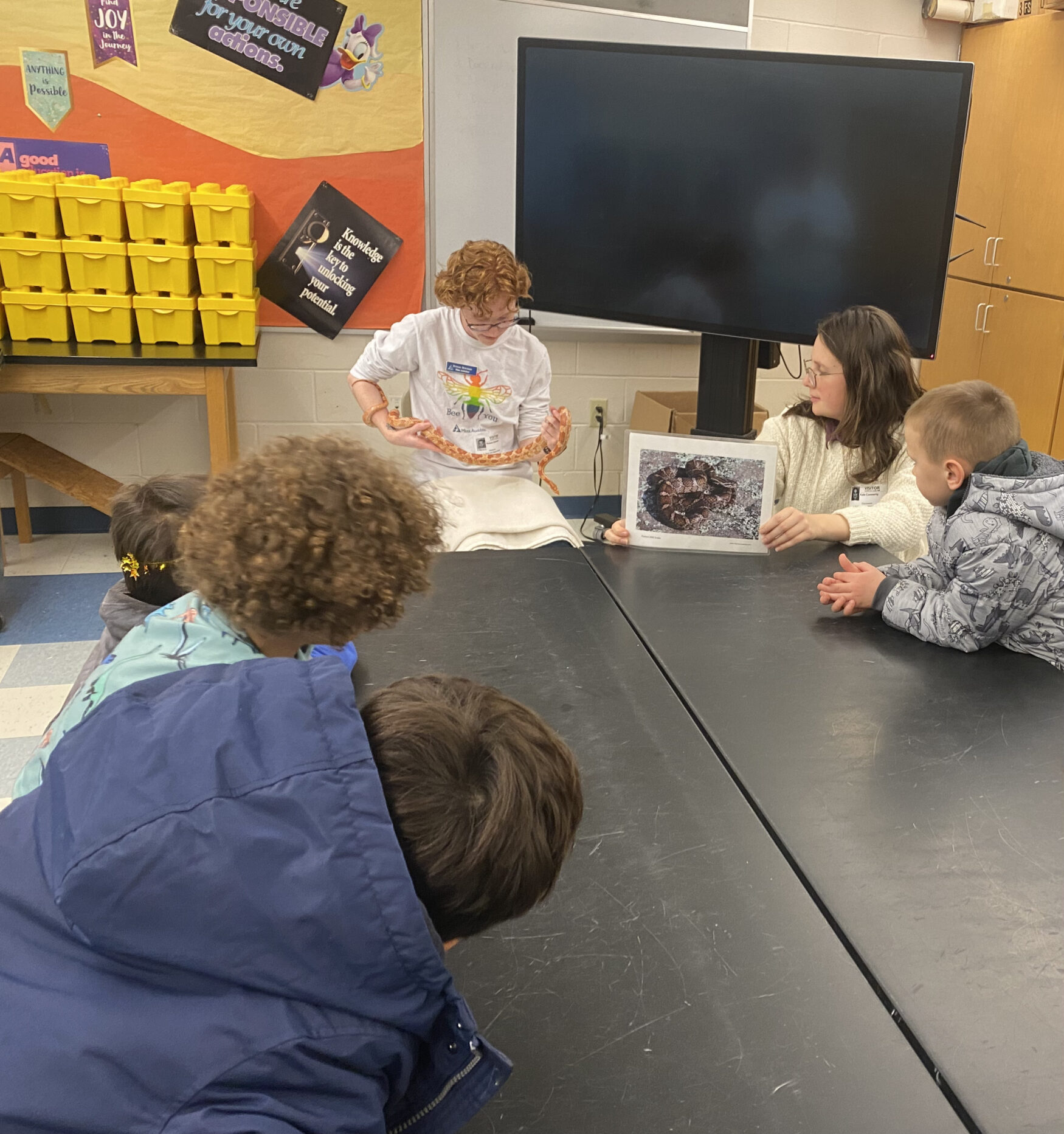
Rowan holding Rocket the snake for students to see.
Pyne Arts Elementary School students met “Rocket” the snake during the Nature Explorers afterschool program on a recent afternoon. Rocket lives at the Drumlin Farm Wildlife Sanctuary, and was brought to the school by Rowan, a staff member at Mass Audubon and an expert at handling the snake. Rocket gets his name from a white mark on his head that looks like a rocket ship taking off.
Kale Connerty, an afterschool environmental educator for the Trust, played a guessing game with the students to see if they could guess what animal was in the cage before it was brought out. They could only ask “yes or no” questions, but they guessed correctly very quickly. They first asked, “does the animal have scales?” which was followed by “does the animal have legs?” When answered “no” to both questions, the students all knew that a snake was the visitor.
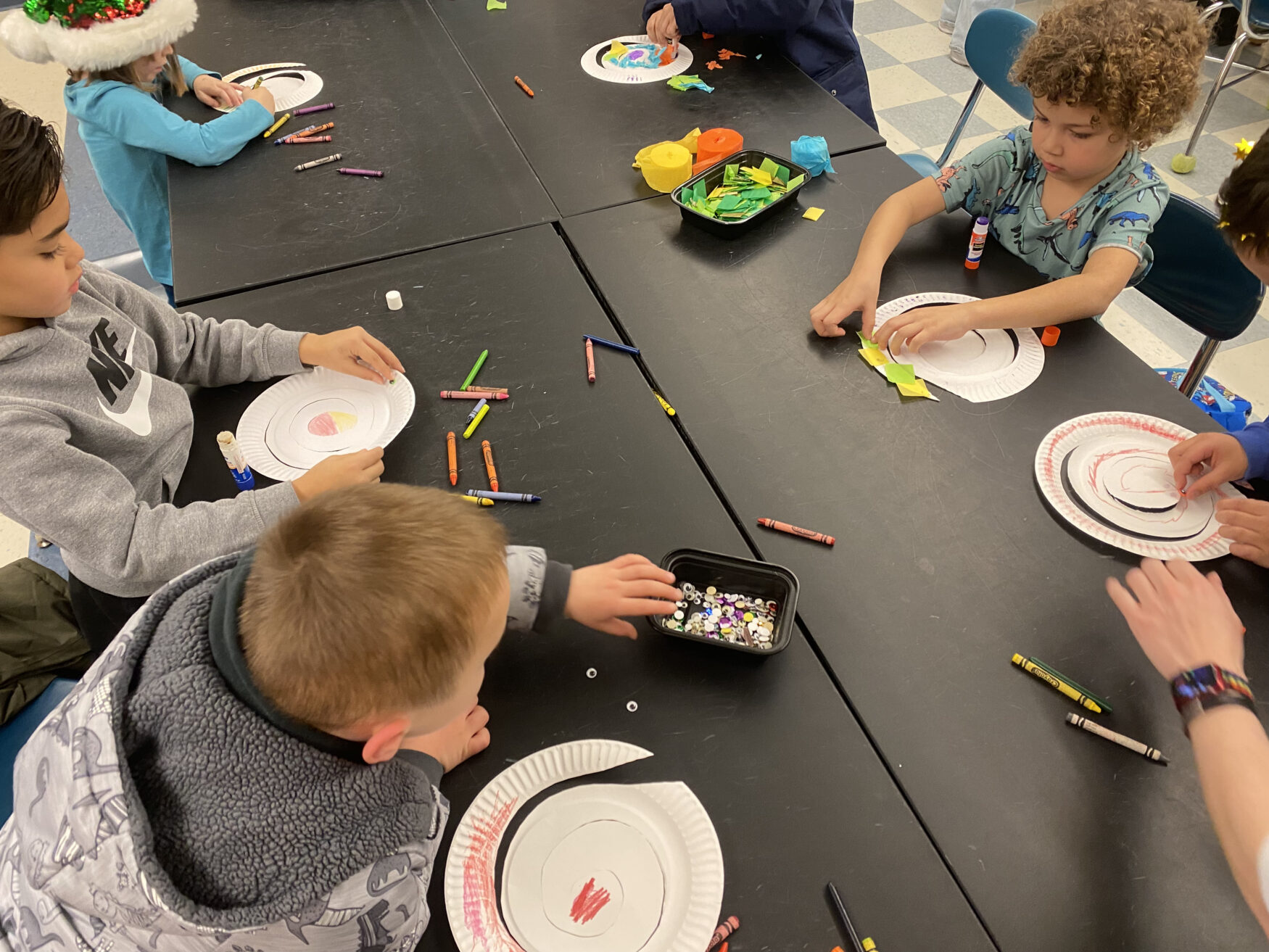
Students making snake crafts.
At first, the kids were frightened to have the snake brought out, but Rowan handled Rocket carefully and calmly and slowly gained the students’ trust. Once the students realized that Rocket was harmless, they moved their seats closer to the animal. Rocket is a corn snake, which is native to the Southeast U.S., but the kids got a lesson on some other snakes that are more local such as milk snakes and garter snakes.
The students were most interested in Rocket’s peculiar diet. They learned that snakes do not need to eat as frequently as humans, so they only eat about once a week. Snakes eat even less when they are brumating, which is like a more mild hibernation for cold-blooded animals. The students were able to answer that the snake was a carnivore because it was a term they learned in a previous afterschool session. It was exciting to see the students apply previous knowledge they learned to the lesson.
To wrap up the day, students got to do a craft. They made a snake by cutting a paper plate into a spiral and adding googly eyes. Not only did the students face their fear of snakes, but they took a liking to the animal, and they got to take home their crafts to remember the experience.
Taking Selfies with Sheep (11/03/23)
One of the Local Parks & Conservation Trust’s most valued partners is Mass Audubon. Together with Mass Audubon and Lowell Public Schools, the Trust coordinates afterschool programs. On a recent Friday afternoon field trip, Lowell High School students from the Trust’s TREES program, an environmental club offered at the Lowell High School, got to take a trip to Lincoln, Massachusetts, to see Mass Audubon’s Drumlin Farm Wildlife Sanctuary.

Me (Michael Van Arnam) next to sheep in their pen.
While there is plenty of nature already to appreciate in Lowell, the field trip allowed the students to familiarize themselves with an important partner of the Trust, meet some of Mass Audubon’s staff, and see the work they do.
Sally Farrow, a teacher naturalist for Mass Audubon, led the tour of Drumlin Farms for us. Sally introduced us to many animal friends in the wildlife sanctuary such as a Barn Owl named Ty, a couple of Black Vultures, and a pony named Midnight. The students had a lot of fun at the farm, but their favorite part of the trip was when they were given the opportunity to feed the farm’s sheep hay and join them in their pen for pictures.
I felt inspired seeing students who go to school in a city have a chance to interact with Mass Audubon’s farm animals. The students had a blast meeting, feeding, and hugging the animals throughout the afternoon. They even got to take selfies with the sheep. I am sure the animals had an enriching experience as well.
An Inspiring Approach to Education (10/13/23)
“I have the best job at Lowell Parks & Conservation. I get to take learning outside the classroom. This is a very meaningful award with Pat’s name on it.” These were some of the words that Jane Calvin, the Executive Director of Lowell Parks & Conservation Trust (LP&CT), shared in an acceptance speech for the second annual Patrick J. Mogan Learning City Award.
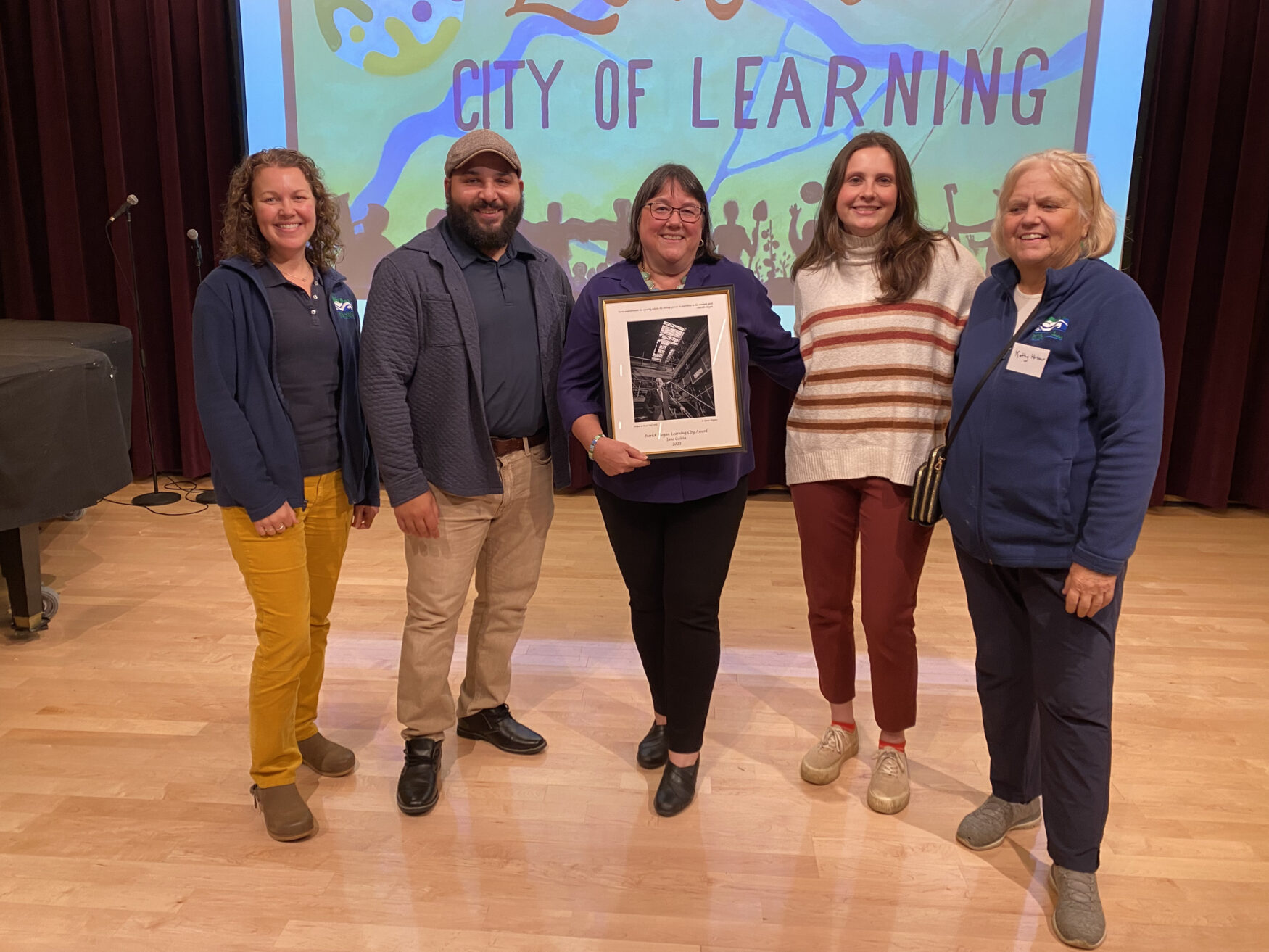
Jane Calvin (center), LP&CT Executive Director, receives Mogan Award, with LP&CT staff.
The late Dr Patrick J. Mogan was a superintendent of Lowell Public Schools, who helped create the the Lowell National Historical Park. He made a career out of being an educator and held the belief that for Lowell to be an educative city truly, the city had to act as an interconnected community and the learning must go beyond the walls of classrooms. Jane embodies those values as Executive Director of the Trust; the Lowell Parks & Conservation Trust has several afterschool programs for all age groups in Lowell that frequently allow students to bring education to the outdoors. Also, many educational events are organized around Lowell for the public to learn about nature such as the recent nature exploration walk that took place at Hawk Valley Farm. Despite Lowell being a historically industrialized city, Jane and the Trust make sure that nature and environmentalism have a place in the city and give the people of Lowell the opportunity to help contribute to those values.
The event took place at The Richard and Nancy Donahue Academic Arts Center at Middlesex Community College and was hosted by UMass Lowell professor John Wooding. A noteworthy crowd was in attendance for the award ceremony. Lowell Mayor Sokhary Chau, UMass Lowell Chancellor Julie Chen, State Representative Vanna Howard, and a spokesperson representing State Representative Lori Trahan were all present in the room, and they all made wonderful speeches honoring Jane. Former Mayor Willam Samaras did the honor of presenting Jane with the award. Jane’s family, friends, and the rest of the staff of LP&CT were also present.
As an intern at the Lowell Parks & Conservation Trust, I get to have Jane as my supervisor. It was very empowering to see my supervisor receive such great praise and recognition from city officials and the people of Lowell. The ceremony made me feel proud to be involved with the Trust and gave me faith that Lowell is filled with good, well-educated people who will continue to improve the city.
Recycling Revamp in Lowell High School With TREES Students (10/02/23)
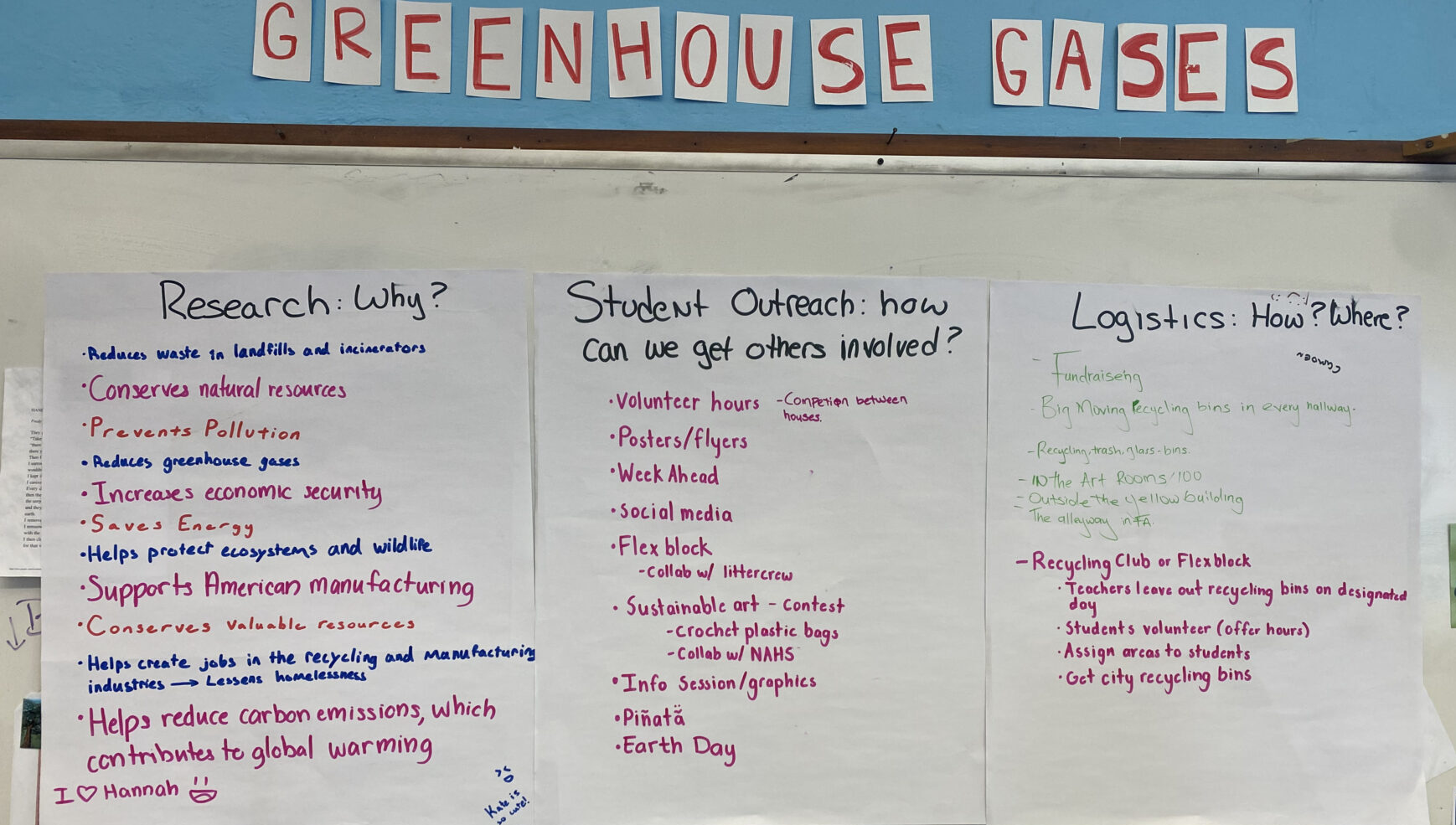
Presentation notes prepared by TREES students about proposed recycling project at Lowell High School.
After the weekend, I got the chance to visit Lowell High School with Antonio Trinidad Martinez (Tony), a staff member at the Lowell Parks and Conservation Trust, to observe an afterschool program called “TREES.” TREES, which stands for Teens Representing Environmental Excellency and Stewardship, is a program for students who are interested in environmentalism; the group learns about local species of plants and animals and they work on environmental projects for the community. It is also only one of many environmental educational programs that the Lowell Parks & Conservation Trust currently offers. TREES is a program for 10th and 11th graders, but other programs offered by the trust cover all student age groups. Tony co-advises the group along with Lowell High School science teachers Tara Goodhue and Carolyn Mcdonough, as well as Mass Audubon teacher naturalist Sally Farrow.
I observed the students working on various poster boards to prepare a presentation intended for the custodial services and the principal of Lowell High School to revamp the recycling process within the school. The students explained to me that the coronavirus impeded Lowell High School’s recycling infrastructure, so they would like to make it more robust again. The co-advisors assisted students when needed, but largely let them work on their own. The students were mature and motivated and showed that they were capable of being autonomous. “Middle schoolers and elementary students need more supervision, but in high school, it is good to start letting students do work on their own”, said Sally. I admired the trust that the advisors gave to the students in TREES, and the students proved to be well-deserving of that trust.
 The current project was admirable, but I also got to learn about past projects TREES has done. TREES has helped the Trust with our Greening the Gateway Program by researching tree species to facilitate planting. Students in TREES have also participated in several Youth Leaders for Climate Justice Summits.
The current project was admirable, but I also got to learn about past projects TREES has done. TREES has helped the Trust with our Greening the Gateway Program by researching tree species to facilitate planting. Students in TREES have also participated in several Youth Leaders for Climate Justice Summits.
Tony emphasized that TREES is a program that does not require a stringent commitment. Students can participate as much or as little as they would like. That way, Tony says, students do not have to choose between TREES and other extracurricular activities like sports. TREES is a great way for Lowell High School students to get involved with making their community more green with their peers.
LP&CT Showing Love for Lowell Trees (09/30/23)
 Last week, I had the privilege of observing a meeting regarding future plans surrounding the UMass Lowell Arboretum, which is a botanical collection of marked local trees that are used for research and conservation while providing natural beauty to Lowell. The meeting was among the advisory committee for the arboretum and was led by Kevin Block, the Ground Operations Manager at UMass Lowell.
Last week, I had the privilege of observing a meeting regarding future plans surrounding the UMass Lowell Arboretum, which is a botanical collection of marked local trees that are used for research and conservation while providing natural beauty to Lowell. The meeting was among the advisory committee for the arboretum and was led by Kevin Block, the Ground Operations Manager at UMass Lowell.
Kevin explained that the arboretum is still a relatively new creation for the university; the arboretum was accredited in February 2022 by ArbNet, an international community of tree professionals who help provide support and resources to arboreta. Craig Thomas, the Director of UMass Lowell’s Sustainability office and member of the advisory committee, projected the interactive map for the arboretum at the meeting but admitted that it is still a work in progress. Kevin’s team says they are taking inspiration from Northeastern University’s interactive map. Still, I had a lot of fun looking at the data from the interactive map, especially the colorful bubble diagrams that represent how common a tree species is around campus.
Jane Calvin, the Executive Director of the Lowell Parks & Conservation Trust, is a member of the advisory committee for the arboretum. Having a staff member from the Lowell Parks & Conservation Trust is valuable for the arboretum because the arboretum is not the first urban forestry project that the Trust has helped work on—as an intern at the Trust, I have started to become familiar with some of the urban forestry projects that the Trust has to offer. One example is that 150-200 trees get planted yearly by the Trust with help from community partners. Also, free trees are offered in a specific city zone for Lowell residents through a program called “Greening the Gateway Cities.” The Trust encourages the community to reach out and offer suggestions for where new trees should be planted in Lowell. The experience and knowledge that the Trust has with urban forestry will help make the arboretum more robust for the community, and will potentially add trees that can then be added to the arboretum’s inventory.
Another way that the Trust can be beneficial for the arboretum is through offering volunteers to make an impact. “We get a lot of corporate groups looking for volunteer work, especially around Earth Day, and they could help out the arboretum” said Jane. Kevin thought it was a great idea, and said that placing physical labels on the arboretum’s trees is a great task to get volunteers involved. Kevin passed around the labels that are used on the arboretum. They were black cards bearing different plants’ names spelled out with shiny, silver letters. I examined a card that read, “Eastern Arborvitae.” I was struck by how pleasing the cards were to look at.
Another topic in the meeting involved discussions about how to achieve donations for the arboretum. The committee brought up ideas for significant donations such as an “adopt a bench” donation which will allow a donor to have a plaque placed on a Lowell bench in honor of their name. A similar idea was the “name a tree” option which would allow donors to see a tree of the arboretum bear a name of their choice. The committee felt it was even more important to set up a sustainers program that would allow people to make smaller, monthly donations. A sustainers program would allow more people in the community to get involved with donating.
Kevin wrapped up the meeting by discussing how the arboretum is now being incorporated into campus planning, which shows that the University is valuing the arboretum, and is not trivializing the project. I left the meeting with great excitement about how the arboretum will continue to have an impact on the university and the city of Lowell, and how Lowell Parks & Conservation Trust will develop its involvement in the arboretum.
Local Students Empowered to Help Their Community (09/23/23)
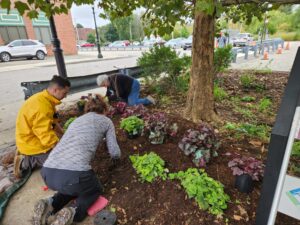
Planting native plants along Concord River Greenway.
On Saturday, I continued my first week as an intern by attending a volunteer event at the downtown end of The Greenway. We met with members of the Lowell Litter Krewe and others from the community to clean up trash and tidy up some of the trail. When I first arrived, I was taken aback by the river’s current; it moved quickly and was rough enough to create some white caps on the water. It was a spectacular sight, and I was excited to work next to it for the day. I hopped over a fence along the path and joined Antonio Trinidad Martinez (Tony), Community Conservation Coordinator for the Lowell Parks & Conservation Trust, in the woods. Also with us were some members of the Environmental Youth Task Force, which Tony also helps to lead. We focused our attention on removing a plant called Japanese knotweed from the railing of the fence and at the edge of the woods. Tony explained that the plant is an invasive species and prevents other native species of plants from thriving in the area. Tony also gave me a little history lesson on the Japanese knotweed; it was once an ornamental plant that people used to decorate their yards in North America, but it made its way into the local ecosystems, where it remains harmful today. The Japanese knotweed was so prevalent in the area where we were standing, and I thought there was no way we could make a notable difference.
But with all of us using our clippers to cut the base of the plants, the removal of the plants went swiftly. The clippers met the stems with a discernable cracking sound, and then we would throw the plants into a collective pile before stuffing them into trash bags. We weren’t able to remove all of them, but the difference made was drastic, and my initial worry was settled. Gabriel, a member of the Environmental Youth Task Force, was an especially adept worker. His trash bag was filled completely with the removed plant, but he was still trying to stuff more into it. With a smile on his face, he turned to me and said, “I love the fact that we’re helping the environment. It really makes me happy.” Around us, other volunteers helped to pick up trash by the riverside. It felt very empowering to be surrounded by so many people who care for their community.
Afterward, we hopped back over the fence and began clipping some overgrown grass on the path, much like we did on Friday. Another member of the Environmental Youth Task Force was Alejandro. He said to me, “We only have one planet and Lowell is a beautiful city. I enjoy the outdoors, and doing this helps me get community service hours for high school.” It was a very profound statement. He also explained to me that the last time he attended a clean-up near the Concord River, there was a drought, so the water was extremely low. I was grateful to be able to work on a day when we could see the river flowing and healthy. We finished our work with mulching like we did the previous day, but we also took the time to do some planting. At the end of the event, I helped bring tools back to the Eco-mobile, which is actually a converted ambulance the Lowell Parks & Conversation Trust uses to transport their equipment to events.
The work over the weekend showed me that the people of Lowell have a vast care for the environment and making sure nature has a place in the city. It was humbling to talk to so many different people from the community and witness how hard they work. If you want to get involved you can look for upcoming events on our website!
Corporate Group Inspires Employees to Get Outside and Make a Difference (09/22/23)
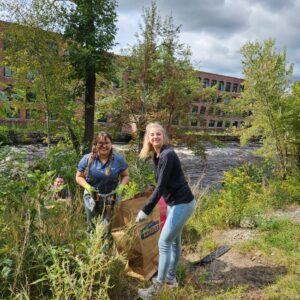
HNTB volunteers remove invasive species and plant native species along Concord River Greenway.
Instead of wrapping up their work week in the office, employees from the HNTB Corporation helped us clean and landscape a section of the Concord River Greenway Park on Friday. Some of the employees came from HNTB’s Chelmsford office, and some from their Boston office, but all were equally excited to lend a hand. It was also my first day as an intern for the Lowell Parks & Conservation Trust, so I got to learn about the Greenway alongside the workers from HNTB.
Jane Calvin, the Executive Director of the Trust, explained to us that the Concord River Greenway is a scenic trail for people to use recreationally. The Greenway is especially impressive because it underscores the beauty of nature despite being in a highly urbanized area. Cleaning the path was fitting volunteer work for HNTB because they specialize in creating and maintaining environmental infrastructure.
Much of the grass on the edge of the Greenway was starting to get quite long and extending into the path. I was handed some clippers, and I joined a few others to trim back the grass. There were also some stairs that led down to the riverside that were also starting to get overtaken by the encroaching grass. After making some progress on the stairs, Abby, an HNTB employee, said, “Wow! I didn’t even realize that there were stairs there.” Jane explained that the stairs not only grant a better view of the rushing river but also serve as a docking point for white water rafting – another activity I did not readily associate with Lowell. I was really starting to realize the depth of what the Lowell Parks & Conservation Trust has to offer throughout the afternoon.
After cutting the grass, the group I was with went to join the others to put down some stone dust on a small rest area off the side of the Greenway. The stone dust was laid out in several bags and resembled wet cement. Spilling and raking the slushy content was the most fun part of the day in my opinion. The bags were quite heavy, but Pete, another worker, was able to carry two bags at a time. It was really impressive and sped up the process. As we made progress spreading the stone dust, many residents passed by on the trail; there were dog walkers, bikers, joggers, and families. They all smiled or said hello as they passed. It was really encouraging to see how important the Greenway is to the community.
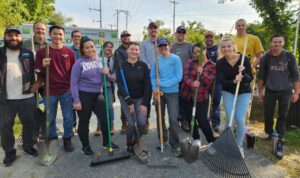
HNTB volunteers after Concord River Greenway maintenance work. Thank you!
We finished off the day by cleaning up the bike racks at the beginning of the trail because the brush had started to impinge on the racks. After removing the greenery from the bike racks and making them functional again, we spread some dark, rich mulch around the base of them. The sun was bright for a September day, and illuminated the beauty that the volunteers helped to create on the trail. “I really like to get outside and help out on days when we can,” said Harrison, another HNTB employee. Harrison said he came from HNTB’s Boston location, so it was cool to have him help despite him not being as familiar with the area.
At the end of the event, we took some group photos all together. The manager at HNTB gave his team some well-deserved praise and told them to enjoy their weekend. They all seemed to leave with a sense of accomplishment and said that they hoped to come back next year!

